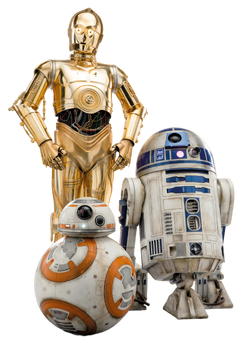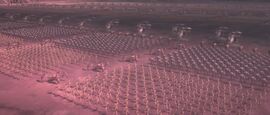| | |
- "You're just a droid. You don't know about real duty, about what it's like to have a brother."
"I am sorry. I always wanted to have human feelings, but I do not." - ―Clone trooper Fives and AZI-3

Protocol droid C-3PO, and astromech droids BB-8 and R2-D2.
Droids, less commonly known as robots and automatons, were mechanical beings that possessed artificial intelligence. They were used in a variety of roles and environments, often those considered too menial or too dangerous for other species, but also in fields that required extensive specialization and knowledge.
History
The earliest origins of droids were lost to history, and, by the time of the New Republic, it was unknown exactly when the first droid was created.[1] Nevertheless, for millennia, droids served in galactic society alongside organic beings.[2] Droids existed as far back as the earliest days of the Jedi Order,[3] which was founded over 5,000 years before the Clone Wars.[4] One such ancient droid, Professor Huyang, served the Jedi for several millennia.[3] As a result of this ancient coexistence with living beings, the galaxy often had an uneven relationship between organics and mechanicals. Records of uprisings and clashes between droids and their organic overlords became increasingly common as droids slowly became more important in galactic society.[2]

During the Clone Wars, the CIS deployed a massive army made up of various battle droid models. The high use of droids in combat lead to an increase in anti-droid sentiment.
During the pan-galactic conflict known as the Clone Wars, the Confederacy of Independent Systems used a variety of battle droids in its fight against the Galactic Republic. This mass-use of droids in combat cemented the idea of the "droid as an existential threat to biological life" narrative in the minds of the Republic.[2] Ultimately, the Republic won the war and was replaced by an authoritarian Galactic Empire. Under the new regime, many people in the galaxy were afraid or otherwise distrustful of droids, due to their bad memories of the conflict.[5] The Rebel Alliance, which opposed the Empire, treated droids not as property but as sentient beings. This feeling was later reciprocated by the New Republic and Resistance.[6]
Definition

Droids were mechanical constructs designed to assist organic lifeforms in various tasks. Depending on the nature of the work they performed, they possessed various degrees of artificial intelligence.[7] Most droids had hard-coded restrictions against harming organics. Notable exceptions included security droids[8] and assassin droids.[5]
Droids came in all sizes and shapes, and many of them resembled humanoid organics, possessing an upright posture, two arms, two legs, hands, feet, one thorax, a neck, and a head.[9] The B1 battle droids were designed to resemble their insectoid Geonosian creators.[10] Likewise, the Colicoids designed the three-legged droidekas in their image.[11] Some droids, like the LOM-series unit, were made to resemble the organics they served.[7]
Contrary to organics, who were born and healed slowly,[12] droids were easily built en masse, were less fragile, and could be repaired easily.[13] They also did not have to learn skills (such as calculation abilities), as they were directly programmed with them. Most droids possessed a form of self awareness, with advanced models even having emotions such as fear for their existence.[12] They did not need to sleep, although they could be deactivated as a form of sleep and had occasional maintenance cycles.[14]

0-0-0 theorized that a special engine powered by human blood could connect a droid to the Force.
Because they were not technically alive, droids were "dead" to the Force,[13] an energy field that connected all living things in the galaxy.[15] The reprogrammed protocol unit Triple-Zero, however, theorized that the Force might flow through a droid equipped with a special engine driven by human blood.[13]
Droids were usually completely obedient and precise, and normally followed their proprietors' orders.[15] Some droids, however, were emancipated and fended for themselves.[16]
Unlike mere machines or primitive computers, droids were capable of developing unique personalities by gathering experiences. They could form friendships, and experience emotions such as happiness, pain, and sadness.[17] To avoid that, most droid owners performed regular memory wipes on their properties.[9]
It was the nature of less complex droids to assume that if a human acted as if they belonged somewhere, then that human did belong there.[18]
Classes of droids
- "For easy identification, droids are traditionally divided into five classes based on their specifications. (Frankly, I think that lumping us together like this is a little rude. I assume this list was developed by a human with zero class.)"
- ―R0-GR

A B1 battle droid
Droids could be entrusted with a multitude of tasks, ranging from running elementary diagnostics to performing complicated medical procedures, or sending communications to flying starships.[7] Depending on their technology, skills, and purpose, droids were grouped into five "classes,"[19][20] also called "degrees."[2]
First class droids
The first class was made up of droids skilled in mathematical, physical, and medical sciences. Examples included the JN-66 analysis droid, the 2-1B surgical droid,[20] the midwife droid,[20] the DD-13 tripedal medical droid, and the GH-7 medical droid.[19]
Second class droids
Droids of the second class were skilled in engineering and technical sciences. Examples included the DUM-series pit droid, the PLNK-series power droid, and the WED-15 Septoid Treadwell.[19]
Third class droids
Third class droids were skilled in social sciences and service functions. Examples included the CZ secretary droid, the LEP servant droid, the FA-5 valet droid, and the BD-3000 luxury droid.[19]
Fourth class droids
E-3PO, an example of a protocol droid
Droids of the fourth class were skilled in military and security functions. Examples included the Guardian police droid, the KX-series security droid, and the B1 battle droid.[19]
Fifth class droids
Fifth class droids were programmed for menial labor and intensive jobs that did not require a high level of intelligence. Examples included the GNK-series power droid,[20] the MSE-6 series repair droid,[20] the IW-37 pincer loader droid, the R-H029 sifter droid, the PK-series worker droid, and the UX-53 Autopolisher MK.II.[19]
Behind the scenes
The word droid is derived from android which means "man-like." Of course the term is erroneously used for "second degree" droids that have nothing common with Humanoids. Droid is the exclusive name for every robotic entity in Star Wars. However, C-3PO and R2-D2 were referred to as "robots" on one occasion in Star Wars: Episode IV A New Hope.
The word droid was stylized as 'droid in the novelization of Star Wars: A New Hope, the apostrophe indicating that droid was a shortened form of the word android. In subsequently published novels, the apostrophe was not used.
Early Star Wars Legends material sometimes spelled droid with an apostrophe ('droid), short for android.
Trademark
George Lucas holds a trademark on the term "droid." The miniature 'mech combat wargame BattleTech was originally released under the name BattleDroids, but was renamed due to trademark issues with Lucasfilm.
Pixar Animation Studios' film The Incredibles (2004) contains a reference to Lucasfilm's droid with the large weapon of destruction, the Omnidroid; an apparently unrelated killer droid of the same name also appears in Star Wars Galaxies. The credits of the film give a nod to Lucasfilm.
From Mickey News [1] (25 November 2004):
- For some viewers that feeling lasts through the closing credits, where a notice that the term "Omnidroid" was used by permission of Lucasfilm Ltd. has prompted some fans to speculate that The Incredibles offers a sneak peak at a character from the next Star Wars film.
- "No. No, no, no," Bird [Brad Bird, director of The Incredibles] says with a laugh, when asked if the secret weapon has a secret of its own. "I like that they think that, but it's more the term 'droid' is Lucas and we made the term Omnidroid (and then got the OK as a courtesy). So, no, there's no sneak. But God bless those fans. They're crazy."
The term "Droid" has been licensed by Verizon Wireless for their line of smartphones based on the Android operating system. Motorola's late-2009 Google Android-based cell phone is called the Droid and this line of phone has been expanded to include other Android-based phones released under Verizon. The term is used under license from Lucasfilm.[21]
Appearances
Non-canon appearances
- Star Wars Epic Yarns: Return of the Jedi
- LEGO Star Wars: Droid Tales Episodes I-III
- Star Wars: Puzzle Droids
- Star Wars: Galaxy of Heroes
Sources
Notes and references
- ↑ Star Wars: Droidography
- ↑ 2.0 2.1 2.2 2.3 Star Wars Propaganda: A History of Persuasive Art in the Galaxy
- ↑ 3.0 3.1
 Huyang in the Encyclopedia (content now obsolete; backup link)
Huyang in the Encyclopedia (content now obsolete; backup link)
- ↑ Tarkin
- ↑ 5.0 5.1 Star Wars: Card Trader
- ↑ Star Wars: The Last Jedi: The Visual Dictionary
- ↑ 7.0 7.1 7.2 Ultimate Star Wars
- ↑ Star Wars: Commander
- ↑ 9.0 9.1 Star Wars: Absolutely Everything You Need to Know
- ↑
 Battle Droid in the Databank (backup link)
Battle Droid in the Databank (backup link)
- ↑ Star Wars Character Encyclopedia: Updated and Expanded
- ↑ 12.0 12.1 What is a Wookiee?
- ↑ 13.0 13.1 13.2 Darth Vader 18: The Shu-Torun War, Part III
- ↑ Servants of the Empire: Imperial Justice
- ↑ 15.0 15.1 Star Wars: Episode IV A New Hope
- ↑ Star Wars: Rogue One: The Ultimate Visual Guide
- ↑ Star Wars Builders: Droids
- ↑ Master & Apprentice
- ↑ 19.0 19.1 19.2 19.3 19.4 19.5 Star Wars: The Visual Encyclopedia
- ↑ 20.0 20.1 20.2 20.3 20.4 Star Wars Super Graphic: A Visual Guide to a Galaxy Far, Far Away
- ↑ http://www.elliotsblog.com/dont-mess-with-verizon-motorola-and-lucasfilm-18391

